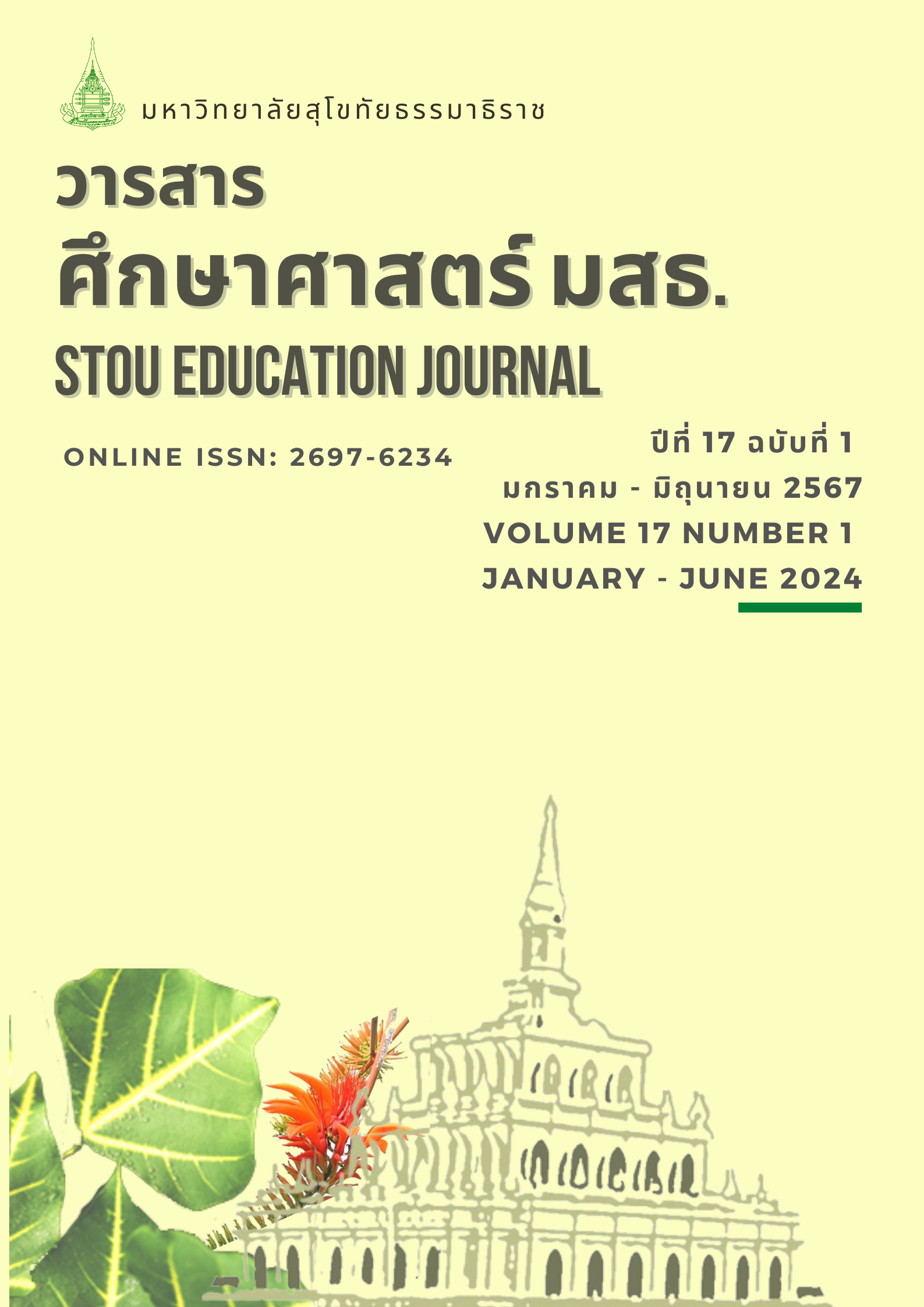The Development of 10th Graders’ Collaborative Problem Solving Competency Using DEEPER Scaffolding Model
Main Article Content
Abstract
The objective of this research was to develop grade 10 students’ Collaborative Problem Solving (CPS) competency using the DEEPER Scaffolding model. The participants were 33 10th graders in the science-math program who studied chemistry at a public school in Bangkok. Data were obtained from the CPS Performance Test. The reliability coefficient of the test was 0.71. Content analysis was used for data analysis by classifying students’ responses according to three rubric criteria: high, medium, and need improvement. The results showed that after learning through the DEEPER Scaffolding model, the majority of children (54.55%) had a high level of CPS competency. It was followed closely by medium level (42.42%). When considering each sub-competency of the CPS under the context of Safety and skills in chemical operations and chemical bonds, the students developed the most of CPS competency in the sub-competency of ‘taking appropriate action to solve the problem’. It was followed by the sub-component of ‘establishing and maintaining team organisation’. The sub-competency in which the children developed the least was ‘establishing and maintaining shared understanding’.
Article Details
References
กระทรวงศึกษาธิการ. (2560). มาตรฐานการเรียนรู้และตัวชี้วัด กลุ่มสาระการเรียนรู้คณิตศาสตร์ วิทยาศาสตร์ และสาระภูมิศาสตร์ ในกลุ่มสาระการเรียนรู้สังคมศึกษา ศาสนา และวัฒนธรรม (ฉบับปรับปรุง พ.ศ.2560) ตามหลักสูตรแกนกลางการศึกษาขั้นพื้นฐานพุทธศักราช 2551. ชุมนุมสหกรณ์การเกษตรแห่งประเทศไทย.
จรูญพงษ์ ชลสินธุ์. (2559). การวิจัยปฏิบัติการเพื่อพัฒนาการจัดการเรียนรู้ตามแนวสะเต็มศึกษาที่เน้นกระบวนการออกแบบเชิงวิศวกรรมที่ส่งเสริมสมรรถนะการแก้ปัญหาแบบร่วมมือ เรื่อง ปริมาณสารสัมพันธ์ [วิทยานิพนธ์ปริญญามหาบัณฑิต ไม่ได้ตีพิมพ์]. มหาวิทยาลัยนเรศวร.
ชนะชัย ทะยอม. (2559). การวิจัยปฏิบัติการเพื่อพัฒนาสมรรถนะการแก้ปัญหาแบบร่วมมือโดยใช้รูปแบบการเรียนรู้แบบเสริมต่อการเรียนรู้บนฐานของการใช้ปัญหาเป็นฐาน เรื่อง ปริมาณสารสัมพันธ์ สำหรับนักเรียนชั้นมัธยมศึกษาปีที่ 4 ห้องเรียนพิเศษวิทยาศาสตร์ [วิทยานิพนธ์ปริญญามหาบัณฑิต ไม่ได้ตีพิมพ์]. มหาวิทยาลัยนเรศวร.
นัตยา หัสมินทร์. (2563). การจัดการเรียนรู้ตามแนวสะเต็มศึกษาที่เน้นกระบวนการออกแบบเชิง วิศวกรรมเพื่อส่งเสริมสมรรถนะการแก้ปัญหาแบบร่วมมือ เรื่อง การเคลื่อนที่แบบต่าง ๆ ของนักเรียนชั้นมัธยมศึกษาปีที่ 4 [วิทยานิพนธ์ปริญญามหาบัณฑิต ไม่ได้ตีพิมพ์]. มหาวิทยาลัยนเรศวร.
บุญชม ศรีสะอาด. (2560). การวิจัยเบื้องต้น ฉบับปรับปรุงใหม่ (พิมพ์ครั้งที่ 10). สุวีริยาสาส์น.
ปาริชาติ ผาสุก. (2560). การพัฒนาสมรรถนะการแก้ปัญหาแบบร่วมมือ เรื่อง ระบบย่อยอาหาร ของนักเรียนชั้นมัธยมศึกษาปีที่ 4 ด้วยการจัดการเรียนรู้ตามแบบ DEEPER Scaffolding Framework [วิทยานิพนธ์ปริญญามหาบัณฑิต ไม่ได้ตีพิมพ์]. มหาวิทยาลัยนเรศวร.
พจงจิตร นาบุญมี. (2560). การจัดการเรียนรู้โดยใช้ปัญหาเป็นฐานเพื่อพัฒนาสมรรถนะการแก้ปัญหาแบบร่วมมือ เรื่อง การเคลื่อนที่แบบหมุนของนักเรียนชั้นมัธยมศึกษาปีที่ 4 [วิทยานิพนธ์ปริญญามหาบัณฑิต ไม่ได้ตีพิมพ์]. มหาวิทยาลัยนเรศวร.
พชรอร บุญลือ. (2562). การจัดการเรียนรู้โดยใช้การแก้ปัญหาอย่างสร้างสรรค์ เรื่อง มนุษย์กับสิ่งแวดล้อมเพื่อส่งเสริมความสามารถในการแก้ปัญหาแบบร่วมมืออย่างสร้างสรรค์ ของนักเรียนชั้นมัธยมศึกษาปีที่ 3 [วิทยานิพนธ์ปริญญามหาบัณฑิต ไม่ได้ตีพิมพ์]. มหาวิทยาลัยนเรศวร.
เวทิสา ตุ้ยเขียว. (2560). การวิจัยปฏิบัติการเพื่อพัฒนาสมรรถนะการแก้ปัญหาแบบร่วมมืออย่างสร้างสรรค์ของนักเรียนชั้นมัธยมศึกษาปีที่ 4 ด้วยการจัดการเรียนรู้แบบสร้างสรรค์เป็นฐาน เรื่อง ปฏิกิริยาเคมี [วิทยานิพนธ์ปริญญามหาบัณฑิต ไม่ได้ตีพิมพ์]. มหาวิทยาลัยนเรศวร.
ศศิวิมล ภูศรีโสม. (2563). การพัฒนากิจกรรมการจัดการเรียนรู้โดยใช้ปัญหาเป็นฐานร่วมกับหลักการการเรียนร่วมกันเพื่อพัฒนาสมรรถนะการแก้ปัญหาแบบร่วมมือของนักเรียนชั้นมัธยมศึกษาปีที่ 4 [วิทยานิพนธ์ปริญญามหาบัณฑิต ไม่ได้ตีพิมพ์]. มหาวิทยาลัยมหาสารคาม.
สถาบันส่งเสริมการสอนวิทยาศาสตร์และเทคโนโลยี (สสวท.). (2563). รายงานประจำปี 2563. PISA 2015 ผลการประเมินการแก้ปัญหาแบบร่วมมือ. https://pisathailand.ipst.ac.th/pisa2015-cps-fullreport/
สมบัติ วรินทรนุวัตร. (2560). คุณลักษณะ 10 ประการ ที่ธุรกิจต้องการในยุคอุตสาหกรรม 4.0. วารสาร TPA News. 21(250), 47-49.
อารีรัตน์ ศรีโชติ. (2561). การพัฒนากิจกรรมการเรียนรู้ตามแนวคิดสะเต็มศึกษา เพื่อส่งเสริมการแก้ปัญหาแบบร่วมมือ เรื่อง ระบบนิเวศ [วิทยานิพนธ์ปริญญามหาบัณฑิต ไม่ได้ตีพิมพ์]. มหาวิทยาลัยนเรศวร.
Antonenko, P. D., Jahanzad, F., & Greenwood, C. M. (2014). Research and teaching: Fostering collaborative problem solving and 21st century skills using the DEEPER scaffolding framework. The Journal of College Science Teaching, 43, 79-88.
Inoue, N. (2015). Beyond action: Psychology of action research for mindful education improvement. Peter Lang Publishing.
Kemmis, S., Mctaggart, R., & Nixon, R. (2014). The action research planner: Doing critical participatory action research. Springer.
Organisation for Economic Co-operation and Development [OECD]. (2013) .PISA 2015 draft collaborative problem solving framework. Framework for 21st century learning. http://www.p21.org/our-work/p21-framework
Partnership for 21st century skill. (2019). Framework for 21st century learning. https://static.battelleforkids.org/documents/p21/P21_Framework_Brief.pdf
United Nations Educational Scientific and Cultural Organization [UNESCO]. (2014). Learning to live together: Education policies and realities in the Asia-Pacific. UNESCO Bangkok. https://unesdoc.unesco.org/ark:/48223/pf0000227208
Wood, C. (2006). The development of creative problem solving in chemistry. Chemistry Education Research and Practice, 7(2), 96-113. https://doi.org/10.1039/B6RP90003H
World Economic Forum. (2020). The future of jobs report revealing the top 10 skills you’ll need by 2020. https://www.weforum.org/agenda/2020/10/top-10-work-skills-of-tomorrow-how-long-it-takes-to-learn-them/


